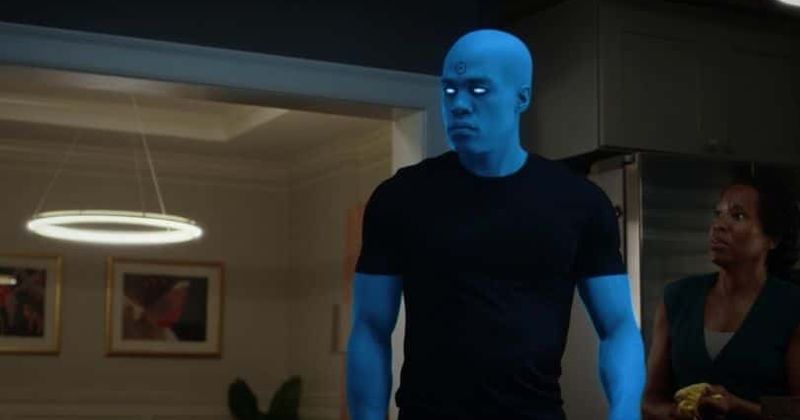Watchmen: The Science of Doctor Manhattan
A physics professor breaks down the science of Watchmen's Doctor Manhattan

Among all the characters populating Alan Moore and Dave Gibbons' Watchmen, the glowing, blue figure of Dr. Manhattan stands out as a god-like being that is seemingly beyond comprehension.

Yet when the filmmakers of 2009's Watchmen approached the character, it was essential to comprehend as much as possible about Dr. Manhattan and his strange powers. So they enlisted the help of James Kakalios, a physics professor at the University of Minnesota who wrote the book, The Physics of Superheroes.
Acting as a science consultant on the movie, Kakalios guided the filmmakers on everything from what a physics lab looks like to the psychology behind obsessed research scientists. But many of the conversations centered on the enigmatic Doctor Manhattan, something Kakalios - a fan of the Watchmen comic books - was more than happy to discuss.
"Most of [Dr. Manhattan's] powers, though not all, have some quantum mechanical aspect to them," Kakalios explains. "We talked about the things you could see that electrons do, and you have to take a major leap of faith to extrapolate it up to Dr. Manhattan doing these things, but somehow it's in the same broad suspension of disbelief."
In the film, as well as the acclaimed comic book series on which it's based, the blue-skinned Doctor Manhattan got his abilities after being caught in a chamber called an "intrinsic field subtractor." According to the story by Alan Moore and Dave Gibbons, the experience turned him into a quantum-based superhero who could seemingly exist outside space and time, teleporting and splitting into several different copies of himself.

Newsarama spoke to Professor Kakalios about a few of his theories on the science behind Dr. Manhattan - first off... what is an "intrinsic field subtractor"?
"In the graphic novel, Wally Weaver says, 'What if there was some sort of field holding everything together except gravity?' They call that the intrinsic field.
Comic deals, prizes and latest news
Get the best comic news, insights, opinions, analysis and more!
While the term 'intrinsic field' isn't used to describe that concept in real science, the idea does have a foundation in reality.
"Scientists right now are saying, 'Aside from gravity, what other forces are holding things together?'" he says. "Electromagnetism is basically the force that holds your atoms together, and then there's a strong nuclear force and a weak nuclear force that work on the inside of your nuclei, inside your atoms. And the strong force holds your nuclei together.
"Just earlier today, sitting in a colloquium by one of my colleagues, he was talking about the unification of the strong force, the weak force, and the electromagnetic force. It only occurs at an energy so vast that we cannot even possibly imagine creating it," Kakalios says. "You'd need a trillion times more powerful particle accelerator than the most powerful particle accelerator ever built to reach those regimes.

"So that chamber is pretty tough that Jon Osterman gets locked into. But those are the types of details that, in terms of the story, are not very significant. And although it would require an almost unimaginable level of power, it is something that you can find under the broad brush of quantum physics."
So understanding this fictional science idea of an 'intrinsic field,' the next question is obvious: if you could turn off someone's intrinsic field, what would happen?
"There'd be no electromagnetism to hold the atoms together, there'd be no strong force to hold the nuclei of the atoms together," says Kakalios. "You would literally be disintegrated at the subatomic level."
"Now, you certainly wouldn't be able to reassemble yourself. But without that, there's no story," Kakalios adds. "The first leap of faith is that they're able to somehow produce enough power to tear him to pieces, and the bigger leap of faith is that he's able to come back."
Speaking of leaps, one of the key aspects of Dr. Manhattan's abilities is that of teleportation. Kakalios says that while 'teleportation' isn't exactly a scientific term, there is a quantum mechanical phenomenon called 'quantum tunneling' that might explain Dr. Manhattan's ability.

"Quantum tunneling is where an electron can be in one metal and it can suddenly show up in another metal, even though it's separated by a vacuum of empty space," he explains. "And it can happen with some probability even if the electron never has enough energy to spark and jump from one metal to the other. Basically, because it has a wavelike nature to it, some of the wave can actually leak out from one metal, and if the wave extends far enough, it can end up in the second metal. And then there's a probability that will be there."
Kakalios says quantum mechanical tunneling is a very well-known concept, having been discovered decades ago.
"This is something that, at the end of the day, I don't know if anyone really, fully understands this. They just kind of get used to it," he laughs. "There are tunneling diodes in your cell phone right now that make use of this quantum mechanical process in order to regulate the currents so that your cell phone functions. And quantum mechanical tunneling is the basis for being able to make microscopes that can see individual atoms in surfaces. So at some point, we've understood this well enough that we can engineer devices so that we can make it a routine phenomena. But it really is very bizarre that it works at all.
"In some sense, it's like teleportation. We don't like to use those words," he says. "But we use a word that's just as incomprehensible: 'tunneling.'"
Because Dr. Manhattan can control himself at the quantum level, his teleportation is most likely similar to quantum tunneling, Kakalios theorizes.
"This is one of those things where you say, 'Well, this is my suspension of disbelief,' even though it turns out to actually be true," he says.
"Doctor Manhattan can obviously adjust his probability function at will, so he can extend his wave function all the way out to Mars and make sure that he shows up where he wants to be," says the expert. "Even for electrons, we don't know how to do something like that. But there is the smallest nugget of some actual, real science behind his teleportation."
A secondary ability to that, in the comics and the movies, is Doctor Manhattan's ability to be in more than one place at once. That too could be explained scientifically - sort of.

"It's not strictly correct, but this is one of those things where there is a phenomena called 'defraction' where if a wave goes through two narrow slits, it creates interference patterns. And instead of having a single wave, you get this very complicated pattern," he says.
If a wave is passing through some boundary, it can appear to be in many locations at once, Kakalios explains. Kakalios used the example of having a laser beam go through a screen, which acts as a series of slits. If you pointed that laser through a screen, then toward a flat wall or surface, the points of laser light would show up as many points of light in a pattern.
"That's laser light, and light is a wave. But you can get the same thing with electrons," Kakalios says. "But you say, wait a second; electrons are not waves. Electrons are little nuggets of matter. And yet quantum mechanics says that there's a wave associated with the motion of electrons, and when you do it just right, you could actually have the electrons creating the same type of a pattern that the laser light appears to. And this phenomena is called 'defraction.'
"In some cases, there's a question of where is the electron? It's kind of spread out all over," he says "Dr. Manhattan, presumably, is able to do this by controlling his quantum mechanical wave function.
"Now, if this were the case, of course, Dr. Manhattan shouldn't be able to independently control all of the guys. They should all be part of the same pattern. But that wavelike nature of the electrons that leads to defraction patterns is the same wavelike nature that leads to the tunneling phenomena that I talked about earlier. So it's all part and parcel of the beautiful mysteries of quantum mechanics. And we can see some aspects of this with Dr. Manhattan."

Our last question for Kakalios is one that, for many people might have been their first - why exactly is Dr. Manhattan blue? While Dr. Manhattan's color in the comic books was most likely just an aesthetic choice of the artist, Kakalios says the reason can also be related to science.
"I talked to the special effect people about why Dr. Manhattan might be blue, because there's a physics reason for it," he says. "There's a phenomena called Cerenkov radiation. And if he's leaking high-energy electrons, he would create a blue glow around him. And presumably, if he'd change the velocity of the electrons, he'd even change how dark a blue he was like he does in the TV studio in the book.
"Because he had to rebuild himself atom by atom, he's presumably got all sorts of spare electrons flying off, giving him a blue glow," Kakalios says. "And those high-speed electrons also are emitted from certain nuclear isotopes when they undergo radioactive decay. And in particular, I say Strontium-90.

"So if you were to expose someone to a radioactive material in the attempt to try to give them cancer, and you wanted to blame it on the radiation that was emitted from Dr. Manhattan, this is actually a physically consistent way in which you might go about doing it," he says. "You would use Strontium-90, and one of the characteristics is these high-speed electrons, called beta rays, and Dr. Manhattan is constantly leaking high-speed electrons, which is why he's glowing blue. So he does have kind of a radioactive signature that you could associate with him."
Of course, while Kakalios can theorize about the science behind Dr. Manhattan, the fact is that it's not any kind of hard fact. For the 2009 film however, he said it gave Zack Snyder and the filmmakers a good foundation on which to build their interpretation of the character.
Plus, he thinks the geeks like him who enjoy these types of comics and films will also like learning at least a small part of the science behind the superheroes.
"It's not like I've now proven this is how Dr. Manhattan does it because that's all just impossible. And if you are upset to find out that Watchmen is fictional, I should have said: Spoiler alert!" Kakalios laughs. "But there is this little nugget of real quantum mechanics that you can find within the framework of the fictional story.
"And if you use this as a jumping-off point to learn a little bit of real science," he said, "well, as we say in physics, better blue than red."
Vaneta has been a freelance writer for Newsarama for over 17 years, covering Marvel and DC, and everything in between. She also works in marketing.


